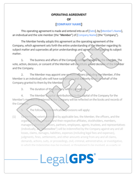2 min read
Partial LLC Membership Transfers: Using Bill of Sale Agreements in 2025
Selling part of your LLC ownership doesn't have to feel like navigating a legal minefield. Whether you're bringing in a new partner, rewarding a key...
9 min read
LegalGPS : Sep. 14, 2025
The entrepreneurial landscape has evolved dramatically, and so have exit strategies. Gone are the days when business owners had to choose between staying fully committed or selling everything. Membership interest purchase agreements offer LLC owners a sophisticated middle path—the ability to monetize part of their investment while maintaining operational control and future upside potential.


Legal GPS Pro
Protect your business with our complete legal subscription service, designed by top startup attorneys.
This partial exit strategy has gained tremendous traction in 2025 as market volatility makes all-or-nothing exits riskier. Smart entrepreneurs are discovering they can achieve liquidity, bring in strategic partners, and diversify their wealth without walking away from businesses they've built from the ground up.
A membership interest purchase agreement is a legal contract that governs the sale of a portion of an LLC owner's membership interest to another party. Unlike selling the entire company, this arrangement allows the original owner to remain involved while transferring specific ownership percentages to buyers who may be investors, employees, or strategic partners.
The agreement functions as both a transaction document and a governance framework. It establishes not only the terms of the sale but also how the new ownership structure will operate moving forward. This includes voting rights, profit distributions, management responsibilities, and future transfer restrictions.
Sarah built her digital marketing agency from zero to $2.8 million in annual revenue over eight years. When a private equity firm offered to buy her out completely for $8.5 million, she hesitated. The business was still growing rapidly, and she wasn't ready to step away.
Instead, Sarah negotiated a membership interest purchase agreement to sell 40% of her LLC to the PE firm for $4.2 million. She maintained majority control, stayed as CEO, and gained access to the firm's network and capital for expansion. Two years later, the agency's value had grown to $15 million, making her retained 60% stake worth $9 million—more than the original full buyout offer.
Economic uncertainty has made partial exits increasingly attractive to business owners seeking to balance risk and reward. Rising interest rates, geopolitical tensions, and market volatility have created an environment where diversification matters more than maximizing single-asset returns.
Partial exits serve multiple strategic purposes beyond simple liquidity. They allow entrepreneurs to test the waters with potential full exit partners, bring in expertise and resources without surrendering control, and create pathways for employee ownership that can improve retention and performance.
The tax advantages have also become more compelling. Rather than facing a massive tax bill from a complete sale, owners can spread their tax liability across multiple years through staged partial exits. This approach often results in significantly lower overall tax burdens while maintaining cash flow from ongoing operations.
The best time to execute a partial exit is during periods of strong performance rather than when you need the money. Buyers pay premium prices for growing businesses with positive momentum. Starting conversations when your business is thriving gives you leverage to negotiate better terms and maintain more control.
Every membership interest purchase agreement must address five critical areas: the purchase price and payment structure, governance and control provisions, ongoing operational responsibilities, transfer restrictions on remaining interests, and exit mechanisms for future transactions.
The purchase price section goes beyond simple dollar amounts. It establishes whether payments occur as lump sums or installments, includes any earn-out provisions tied to future performance, and specifies how closing adjustments will be calculated based on working capital, debt levels, or other financial metrics at the transaction date.

Membership Interest Purchase Agreement (Partial Exit)
Selling part of your ownership in an LLC? This agreement spells out the terms for a partial exit including valuation payment terms and updated ownership rights.
Trusted by 1,000+ businesses to safeguard their LLCs.
Governance provisions determine how decisions get made in the new ownership structure. This includes voting thresholds for major decisions, board composition if applicable, and management appointment rights. Clear governance structures prevent conflicts and ensure smooth operations post-transaction.
Marcus owned 100% of his software development company when his key employees started receiving competing job offers. Rather than lose his best talent, he created a membership interest purchase agreement allowing employees to buy into the company over time.
The agreement structured purchases as 2% annual allocations at fair market value, paid through salary deferrals over three years. It included governance provisions giving employee-owners input on major strategic decisions while preserving Marcus's ultimate control. Five employees participated, reducing Marcus's ownership to 90% while creating powerful retention incentives. The company's revenue grew 40% the following year as employee-owners drove performance improvements.
Accurate valuation forms the foundation of any successful membership interest purchase agreement. Unlike publicly traded companies with market-determined prices, LLC valuations require careful analysis of financial performance, market conditions, and company-specific factors that affect value.
The most common approach combines multiple valuation methodologies to establish a fair price range. Income-based methods like discounted cash flow analysis project future earnings and discount them to present value. Market-based approaches compare the LLC to similar companies that have sold recently. Asset-based methods focus on the underlying value of company assets minus liabilities.
Even when buyers and sellers agree on general terms, independent professional valuations prevent disputes and provide legal protection. The cost of a thorough business valuation—typically $15,000 to $50,000—is minimal compared to potential litigation costs from valuation disagreements later.
Discounts often apply to minority interests even in partial sales. Lack of marketability discounts reflect the difficulty of selling LLC interests compared to public stock. Control discounts may apply when the purchased interest doesn't convey meaningful decision-making power. These discounts typically range from 10% to 40% depending on specific circumstances.
Jennifer's fast-casual restaurant chain generated $12 million in annual revenue across six locations when she decided to sell 25% to a strategic investor. Initial valuations ranged from $8 million to $18 million depending on methodology.
The income approach valued the business at $15 million based on projected cash flows and a 12% discount rate. Market comparisons suggested $12 million based on recent restaurant chain sales. Asset-based valuation showed $8 million focusing on real estate, equipment, and brand value.
The final agreement settled on $13.5 million total valuation, with Jennifer selling her 25% stake for $3.375 million. The buyer accepted a 15% minority discount but negotiated performance escalators that could increase the price by up to $1 million based on future growth metrics.
The tax consequences of selling LLC membership interests can significantly impact the net proceeds from partial exits. Unlike corporate stock sales that typically receive capital gains treatment, LLC interest sales may generate ordinary income depending on the company's assets and operations.
Section 751 of the Internal Revenue Code requires careful attention in LLC sales. If the LLC holds "hot assets" like inventory, accounts receivable, or depreciated equipment, a portion of the sale proceeds may be taxed as ordinary income rather than capital gains. This distinction can increase tax liability by 15-20% for high-income sellers.

Installment sales provide one strategy for managing tax impact across multiple years. Rather than receiving the full purchase price at closing, sellers can structure payments over several years to spread the tax burden. This approach works particularly well for partial exits where sellers maintain ongoing involvement in the business.
David's precision manufacturing LLC was valued at $20 million when he sold 30% to a private investor. The company's $3 million in inventory and $800,000 in depreciated equipment triggered Section 751 treatment for a portion of the sale.
Without planning, David would have owed approximately $780,000 in federal taxes on the $6 million sale proceeds. His tax advisor structured the transaction as a five-year installment sale with 20% paid annually. This approach reduced his annual tax burden to roughly $156,000 while allowing him to invest the deferred proceeds in other opportunities.
The installment structure also included interest payments on the unpaid balance, generating additional returns while deferring taxes. Over the five-year period, David's effective tax rate on the transaction dropped from 39% to 32% due to the timing benefits and interest income.
The complexity of membership interest purchase agreements creates numerous opportunities for costly mistakes. The most dangerous pitfalls often stem from inadequate documentation, unrealistic expectations about ongoing relationships, and failure to plan for future scenarios that could affect the partnership.
Inadequate buy-sell provisions rank among the most expensive oversights. Many agreements focus heavily on the initial sale terms while neglecting to address what happens if relationships sour, performance declines, or parties want to exit later. Without clear mechanisms for resolving disputes or facilitating future transfers, partial exit partners can become trapped in dysfunctional relationships.
The most successful membership interest purchase agreements include detailed exit provisions from day one. This includes buy-sell triggers, valuation methodologies for future transactions, and dispute resolution processes. Addressing these issues when relationships are good prevents expensive conflicts later.
Valuation disputes frequently arise when agreements lack specific methodologies for future transactions. Initial sales may proceed smoothly with professional valuations, but later transfers often rely on simplified formulas that don't reflect changing business conditions. These disputes can paralyze operations and destroy business relationships.
Tom sold 45% of his consulting firm to his business partner through a membership interest purchase agreement that seemed comprehensive at the time. However, the agreement failed to address what would happen if the partners disagreed about business strategy or wanted to bring in additional investors.
Two years later, Tom wanted to expand internationally while his partner preferred focusing on local markets. The deadlock lasted eight months, during which time the business lost three major clients and several key employees. The lack of dispute resolution mechanisms in their original agreement meant expensive litigation was their only option.
The legal battle cost both parties over $300,000 and ultimately forced a company dissolution that destroyed most of the business value. A well-drafted agreement with mediation requirements and deadlock-breaking provisions could have preserved the business and the relationship.
Professional valuations for LLC membership interests require sophisticated analysis that goes beyond simple revenue multiples or book values. The choice of methodology significantly impacts the final purchase price and should align with the LLC's industry, growth stage, and specific circumstances.
Discounted cash flow analysis works best for mature LLCs with predictable cash flows and established market positions. This approach projects future earnings over five to ten years, then calculates present value using discount rates that reflect the business's risk profile. Technology companies, professional services firms, and other asset-light businesses often favor this methodology.
Market multiple approaches compare the LLC to similar companies based on metrics like revenue, EBITDA, or customer counts. This methodology requires access to comparable transaction data and works best in industries with active M&A markets. Manufacturing companies, retail businesses, and other asset-heavy industries frequently use market-based valuations.
Lisa's accounting firm generated $4.8 million in annual revenue with 28% EBITDA margins when she decided to sell 40% to a younger partner. The valuation process examined three different approaches to establish a fair price range.
The income approach projected five years of cash flows based on historical growth rates and industry trends. Using a 15% discount rate appropriate for professional services firms, this analysis suggested a $12.5 million total valuation.
Market comparisons looked at twelve recent accounting firm sales in similar markets. The median sale price was 2.8 times revenue and 9.2 times EBITDA, suggesting valuations between $13.4 million and $12.2 million respectively.
The final agreement averaged these approaches at $12.7 million, with Lisa selling her 40% stake for $5.08 million. The structure included earnout provisions that could increase the price by up to 15% if the firm met specific growth and profitability targets over the following three years.
The legal and financial complexity of membership interest purchase agreements makes professional guidance essential rather than optional. Attempting to draft these agreements without experienced legal counsel virtually guarantees expensive problems that far exceed professional fees.
Tax planning requires specialized expertise that general practitioners may lack. The intersection of partnership tax law, state regulations, and transaction structuring creates numerous opportunities for optimization—or catastrophic mistakes. Engaging tax professionals early in the process can save hundreds of thousands of dollars in unnecessary tax liability.
Valuation professionals provide objective analysis that protects both buyers and sellers from overpaying or underpricing transactions. Their independence also provides legal protection if valuation disputes arise later. The cost of professional valuations typically represents less than 1% of transaction values while providing substantial risk mitigation.
Mike's construction company was thriving when a competitor offered to buy 35% of his LLC. The initial handshake deal seemed straightforward: $2.8 million for 35% ownership with Mike remaining as managing member.
Before signing, Mike's attorney identified several problematic issues. The buyer wanted veto rights over major expenditures, which could have paralyzed operations. The agreement lacked provisions for handling liability from pre-closing projects. Most importantly, the purchase price calculation didn't account for $400,000 in equipment loans that would transfer with the membership interests.
Professional legal review resulted in a restructured deal at $2.4 million that better reflected the actual net value being transferred. The revised agreement protected Mike's operational control while giving the buyer appropriate investor protections. The legal fees of $35,000 saved Mike from a deal that could have cost him hundreds of thousands in hidden liabilities and lost control.
Membership interest purchase agreements represent powerful tools for entrepreneurs seeking liquidity without sacrificing control or future upside potential. Success depends on thorough planning, professional guidance, and realistic expectations about the ongoing partnership dynamics these transactions create.
The key to successful partial exits lies in viewing them as long-term partnerships rather than simple financial transactions. When structured properly with appropriate legal documentation and tax planning, these agreements can provide the best of both worlds: immediate liquidity and continued participation in business growth.
Ready to explore partial exit strategies for your LLC? Legal GPS offers comprehensive templates and resources to help you navigate membership interest purchase agreements with confidence. Our Pro subscription includes expert guidance and customizable documents designed specifically for growing businesses ready to take their next strategic step.

Legal GPS Pro
Protect your business with our complete legal subscription service, designed by top startup attorneys.
|
Premium Template
Single-use Template |
Legal GPS Pro
Unlimited Access, Best Value |
|
|
| Choose Template | Learn More |
| Trusted by 1000+ businesses | |
Table of Contents

2 min read
Selling part of your LLC ownership doesn't have to feel like navigating a legal minefield. Whether you're bringing in a new partner, rewarding a key...

Selling your LLC represents one of the most significant financial transactions you'll likely make as a business owner. Unlike selling corporate stock...

Selling a portion of your LLC ownership allows you to bring in new partners, raise capital, or reduce your involvement in the business while...